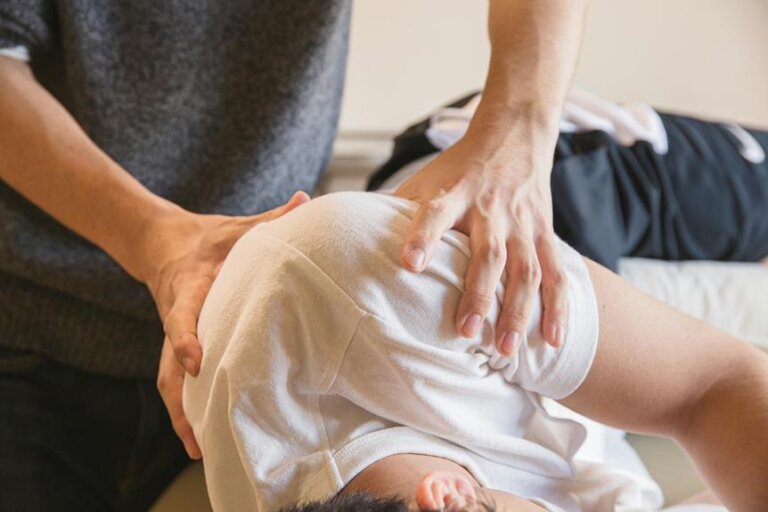Natural Remedies for Back Pain Relief in Your 50s
If you've ever felt like your back was as stiff as a board, finding relief in your 50s can be a game-changer. Imagine being able to move with more ease and comfort, reclaiming some of that youthful flexibility you thought was long gone.
But how can you achieve this without resorting to drastic measures or invasive procedures? Explore a range of natural remedies that can offer you a path to potentially easing your back pain and improving your quality of life.
Stretching and Mobility Exercises
To maintain flexibility and reduce back pain in your 50s, incorporate stretching and mobility exercises into your daily routine. Begin your day with gentle stretches to wake up your muscles and improve circulation. Focus on movements that target the back, hips, and hamstrings, as these areas often contribute to back pain. Incorporating dynamic stretches like leg swings or arm circles can also help prepare your body for the day ahead.
Throughout the day, make an effort to stand up and move around regularly, especially if you have a sedentary job. Simple mobility exercises such as neck rolls, shoulder shrugs, and hip rotations can prevent stiffness and promote better posture. Remember to take breaks from sitting to stretch and walk around every hour.
In the evening, wind down with a stretching routine to relax your muscles and release tension. Yoga or Pilates can be excellent choices for improving flexibility and strengthening your core, both of which are essential for a healthy back. Consistency is key, so aim to make stretching and mobility exercises a daily habit to support your back health in your 50s.
Mindfulness and Stress Management
Incorporate mindfulness practices and stress management techniques into your daily routine to enhance your overall well-being and further alleviate back pain in your 50s. Stress can exacerbate back pain, so finding ways to manage stress is crucial.
Mindfulness meditation, deep breathing exercises, and progressive muscle relaxation are effective techniques to reduce stress levels. By practicing mindfulness, you can increase your awareness of your body and emotions, helping you identify and address sources of stress that may contribute to your back pain.
Additionally, engaging in activities that promote relaxation, such as yoga or tai chi, can not only reduce stress but also improve flexibility and strengthen the muscles that support your spine. These mind-body practices can enhance your overall physical and mental well-being, leading to a reduction in back pain symptoms.
Remember to take breaks throughout your day to practice mindfulness and stress-relief techniques, giving yourself moments of peace and relaxation amidst the demands of daily life.
Proper Ergonomics and Posture
Maintaining proper ergonomics and posture is essential for reducing back pain and promoting overall spinal health in your 50s. When sitting for extended periods, ensure your chair supports your lower back and keeps your feet flat on the floor. Position your computer screen at eye level to prevent straining your neck. Remember to stand up and stretch every 30 minutes to alleviate pressure on your spine. When lifting objects, bend at the knees and keep the item close to your body to avoid unnecessary strain on your back muscles.
Additionally, pay attention to your sleeping position. Use a mattress and pillows that support the natural curves of your spine. Avoid sleeping on your stomach as it can lead to neck and back pain. When standing, distribute your weight evenly on both feet and avoid locking your knees. Practicing good posture throughout the day can significantly reduce the risk of back pain and improve your overall spinal health in your 50s.
Herbal Supplements and Remedies
Consider incorporating herbal supplements and remedies into your routine to explore natural options for managing back pain in your 50s. Certain herbs like turmeric, ginger, and devil's claw have anti-inflammatory properties that can help reduce pain and inflammation in the back. Turmeric, in particular, contains curcumin, which has been shown to have similar effects to over-the-counter pain medications. Ginger can also help alleviate muscle soreness and improve circulation, which may aid in relieving back pain. Devil's claw has been used for centuries to treat pain and inflammation, making it a popular choice for those seeking natural remedies.
Additionally, supplements like magnesium and white willow bark may also provide relief for back pain. Magnesium helps relax muscles and nerves, potentially reducing tension in the back. White willow bark contains salicin, a compound similar to aspirin, which can help alleviate pain. Before starting any herbal supplements, it's essential to consult with a healthcare provider to ensure they're safe and appropriate for your individual needs.
Massage Therapy and Acupuncture
For back pain relief in your 50s, explore the benefits of massage therapy and acupuncture as alternative treatments. Massage therapy can help alleviate back pain by loosening tight muscles, improving blood flow, and promoting relaxation. A skilled massage therapist can target specific areas of discomfort, reducing tension and increasing flexibility. Additionally, the soothing nature of massage can provide a sense of overall well-being, which is beneficial for both physical and mental health.
Acupuncture, on the other hand, involves the insertion of thin needles into specific points on the body to help relieve pain and promote healing. In traditional Chinese medicine, it's believed that stimulating these points can correct imbalances in the body's energy flow. Many individuals find acupuncture to be effective in reducing back pain, improving range of motion, and enhancing overall quality of life.
Both massage therapy and acupuncture offer natural and holistic approaches to managing back pain, and they can be valuable complements to other treatments or therapies you may be exploring. Consider incorporating these alternative options into your back pain relief regimen to see if they provide you with the relief you seek.
Frequently Asked Questions
How Can Social Support and Community Involvement Help With Managing Back Pain in Your 50s?
Having a strong support system and being involved in your community can alleviate back pain in your 50s. Social interactions and activities boost morale, reduce stress, and provide emotional comfort, contributing to better pain management and overall well-being.
Are There Specific Foods or Dietary Changes That Can Help Alleviate Back Pain in Older Adults?
You know, making dietary adjustments can be a game-changer for back pain relief. Incorporating anti-inflammatory foods like leafy greens, berries, and fatty fish can help reduce discomfort and support overall spine health.
Can Practicing Yoga or Tai Chi Improve Flexibility and Reduce Back Pain in Your 50s?
Practicing yoga or tai chi in your 50s can improve flexibility and reduce back pain. These activities help strengthen core muscles, increase range of motion, and promote relaxation, all crucial for managing and preventing discomfort.
Are There Any Specific Breathing Techniques or Relaxation Exercises That Can Help With Managing Back Pain?
To manage back pain, try deep breathing exercises to relax tense muscles. Practice mindfulness meditation for stress relief. Stay consistent for best results. Remember, relaxation techniques can be effective in alleviating discomfort and promoting healing.
How Important Is Maintaining a Healthy Weight in Preventing and Managing Back Pain as You Age?
Maintaining a healthy weight is crucial for preventing and managing back pain as you age. Excess weight adds strain to your spine, leading to increased discomfort. Shedding pounds can lessen pressure on your back, reducing pain and improving overall mobility.
Conclusion
In conclusion, remember that Rome wasn't built in a day, and neither is back pain relief. By incorporating stretching, mindfulness, proper ergonomics, herbal remedies, and therapeutic treatments, you can effectively manage and alleviate your back pain in your 50s.
Consistency is key, so don't give up if you don't see immediate results. Stay committed to your natural remedies and remember that slow and steady wins the race when it comes to finding relief for your back pain.






